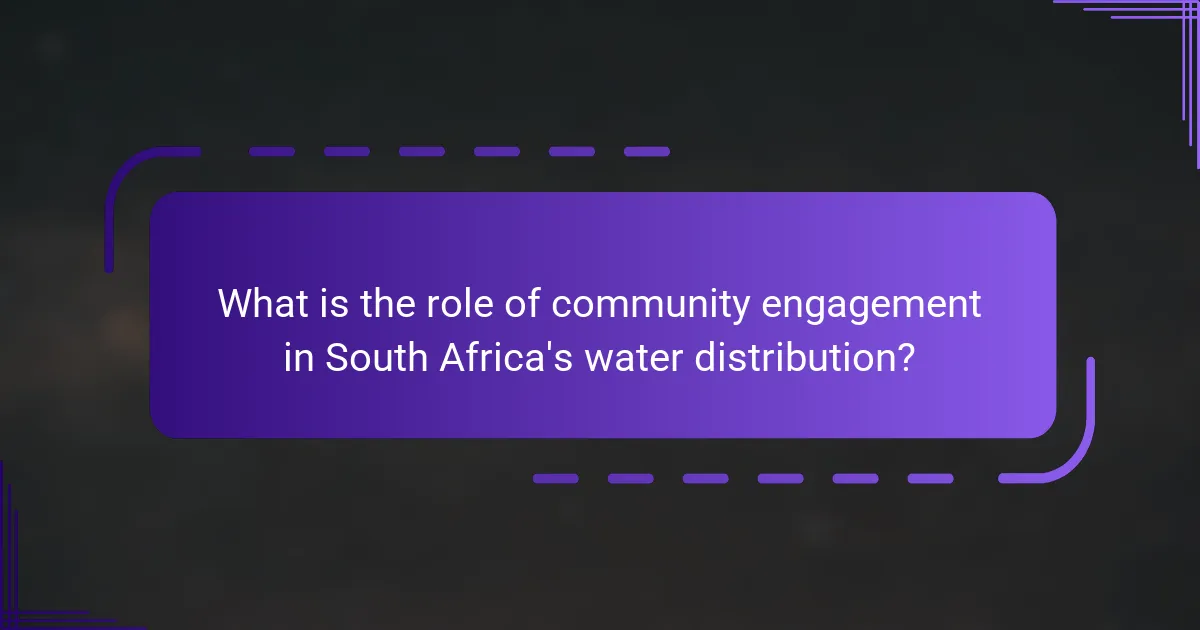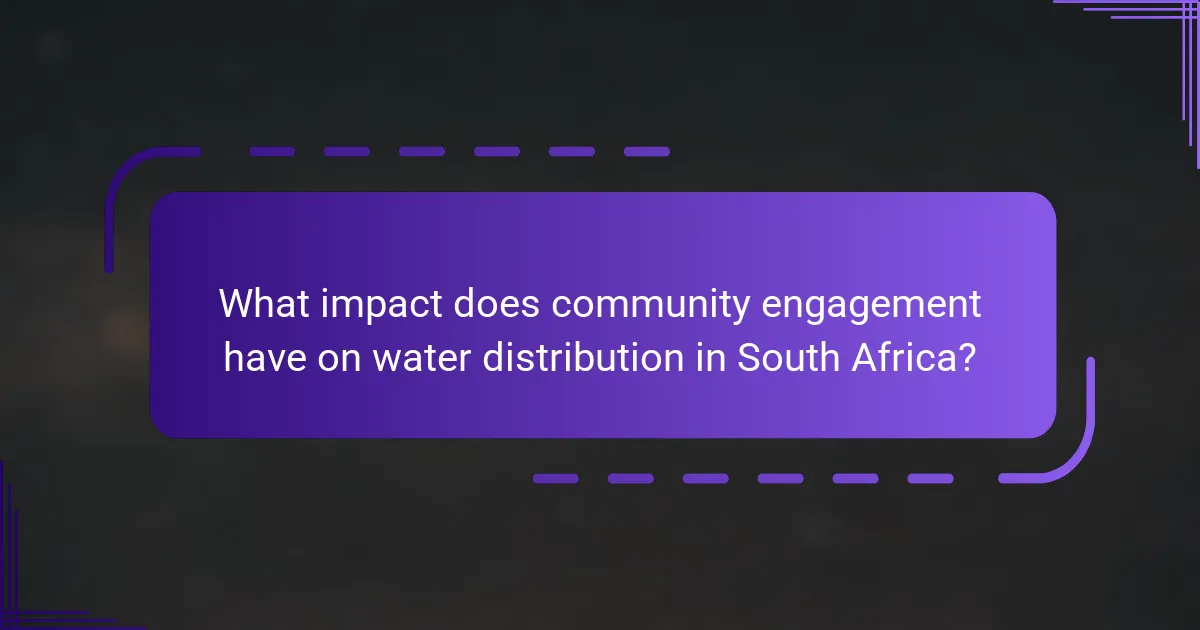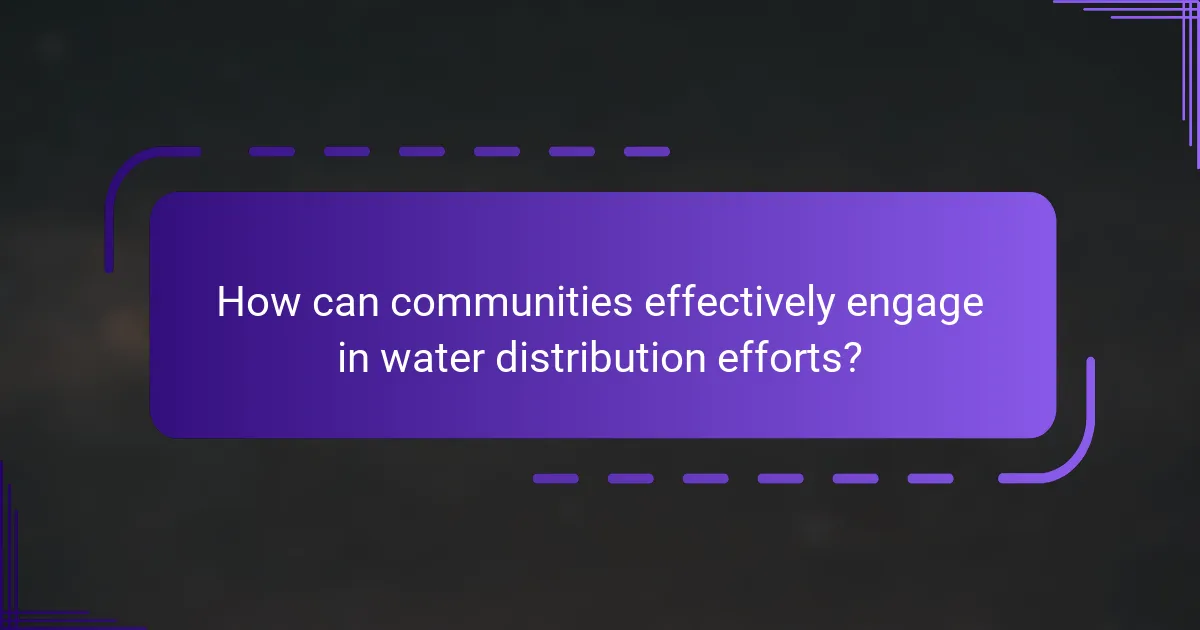Community engagement is a vital component of water distribution in South Africa, facilitating collaboration between local communities and water authorities. This collaboration enhances transparency, accountability, and effectiveness in water management practices. Engaged communities can identify specific local needs, promote sustainable practices, and participate in decision-making processes, leading to improved water service delivery. Strategies such as organizing local committees, conducting educational workshops, and utilizing social media are essential in fostering community involvement, ultimately ensuring equitable access to water resources. The article examines the impact of community engagement on water distribution, emphasizing the importance of education and participation in achieving sustainable water management.

What is the role of community engagement in South Africa’s water distribution?
Community engagement plays a crucial role in South Africa’s water distribution. It fosters collaboration between local communities and water authorities. This collaboration enhances transparency and accountability in water management. Engaged communities are more likely to report issues and participate in decision-making processes. For instance, community forums allow residents to voice concerns about water quality and access. Studies show that areas with active community involvement experience improved water service delivery. Furthermore, education initiatives empower residents to manage water resources sustainably. Overall, community engagement leads to more effective and equitable water distribution in South Africa.
Why is community engagement important in water distribution?
Community engagement is crucial in water distribution because it fosters trust and collaboration between providers and users. Engaged communities are more likely to participate in decision-making processes. This participation leads to better understanding of local water needs and challenges. It also encourages accountability in water management practices. Studies show that communities involved in water governance experience improved service delivery. For instance, the South African Water Services Act emphasizes public participation in water service planning. Effective engagement can reduce conflicts and enhance the sustainability of water resources. Overall, community engagement ensures that water distribution systems are responsive and equitable.
What are the key benefits of involving communities in water distribution?
Involving communities in water distribution enhances efficiency and sustainability. Community participation leads to better identification of local needs. This ensures that the water distribution system is tailored to specific community requirements. Active involvement fosters a sense of ownership among residents. When communities feel responsible, they are more likely to maintain and protect water resources. Studies show that community-managed water systems have lower operational costs. For example, a 2016 study by the World Bank highlighted that local management reduced water loss by up to 30%. Additionally, involving communities improves transparency and accountability in water governance. This builds trust between local authorities and residents, facilitating better cooperation.
How does community engagement enhance water management practices?
Community engagement enhances water management practices by fostering collaboration and local knowledge. Engaged communities can identify specific water issues, leading to tailored solutions. Participation encourages accountability among stakeholders, ensuring effective implementation of water policies. Research shows that community involvement can improve water conservation efforts. For example, a study by the Water Research Commission found that local participation in water management led to a 30% increase in sustainable practices. Engaged citizens also contribute to monitoring water quality, which enhances overall management effectiveness. Thus, community engagement is crucial for developing responsive and sustainable water management strategies.
What are the forms of community engagement in water distribution?
Community engagement in water distribution includes education, participation, and collaboration. Education involves informing communities about water conservation and management practices. Participation encourages local residents to take part in decision-making processes related to water distribution. Collaboration includes partnerships between local governments, NGOs, and community members to improve water access. These forms of engagement help ensure that water distribution systems meet the needs of the community effectively. Studies show that engaged communities are more likely to support sustainable water practices and maintenance of infrastructure.
What types of educational programs are implemented for community engagement?
Educational programs for community engagement include workshops, training sessions, and awareness campaigns. Workshops focus on practical skills related to water conservation and management. Training sessions educate community members on sustainable practices. Awareness campaigns aim to inform the public about water issues and promote responsible usage. These programs encourage participation and enhance knowledge among community members. They are often tailored to address specific local water challenges. Research shows that such programs improve community involvement in water distribution decisions. For instance, the South African Water Research Commission highlights the effectiveness of community-based educational initiatives.
How do community participation initiatives vary across different regions?
Community participation initiatives vary significantly across different regions. In urban areas, initiatives often focus on organized forums and stakeholder meetings. These settings encourage dialogue between residents and local authorities. Conversely, rural regions may rely on informal gatherings and community leaders to facilitate participation. This approach fosters trust and collective decision-making.
Additionally, socioeconomic factors influence the nature of participation. Wealthier regions may have more resources for structured programs. In contrast, disadvantaged areas often depend on grassroots efforts for engagement. Cultural contexts also shape participation styles. Some communities prioritize consensus-building, while others may adopt more confrontational approaches.
Research indicates that effective participation leads to better water management outcomes. For example, a study by the Water Research Commission highlights the positive impact of community engagement on water distribution efficiency in various South African regions. This evidence underscores the importance of tailored participation initiatives based on regional characteristics.

What impact does community engagement have on water distribution in South Africa?
Community engagement significantly enhances water distribution in South Africa. It fosters collaboration between local communities and authorities. This collaboration leads to improved water management practices. Engaged communities can identify specific local needs and challenges. This local knowledge helps tailor solutions effectively. Studies show that community participation increases accountability in water service delivery. For instance, the Water Research Commission reported that community involvement reduces water wastage. Engaged citizens also promote sustainable practices, ensuring long-term water availability. Overall, community engagement is crucial for optimizing water distribution in South Africa.
How does community engagement influence water access and equity?
Community engagement significantly influences water access and equity. Engaging communities fosters collaboration between local governments and residents. This collaboration ensures that water policies reflect the needs of the community. Increased participation leads to more equitable distribution of water resources. Studies show that communities involved in decision-making have better access to clean water. For instance, the South African Human Sciences Research Council reports that participatory water management improves service delivery. Additionally, community engagement raises awareness about water conservation and equitable usage. This awareness helps address disparities in water access among different socioeconomic groups. Ultimately, active community involvement promotes sustainable and fair water distribution.
What evidence exists to support the impact of community engagement on water distribution?
Community engagement significantly impacts water distribution. Studies show that involving local communities leads to improved water management. For instance, the “Community-Based Water Management” report by the World Bank highlights successful projects in South Africa. These projects demonstrate enhanced service delivery and increased accountability. Additionally, the South African Department of Water and Sanitation reports that community participation reduces conflicts over water access. Engaged communities are more likely to maintain water infrastructure. This results in sustainable water distribution systems. Thus, evidence supports that community engagement is vital for effective water distribution.
How do community-led initiatives improve water quality and availability?
Community-led initiatives improve water quality and availability by fostering local engagement and responsibility. These initiatives often involve residents in the management of water resources. When communities participate, they can identify specific local water issues. This localized knowledge leads to more effective solutions.
For example, community-led projects may include building and maintaining water filtration systems. These systems can significantly reduce contaminants in drinking water. According to a study by the International Water Management Institute, community involvement can lead to a 30% increase in water access and quality.
Additionally, education programs raise awareness about sustainable water practices. This education empowers individuals to conserve water and reduce pollution. Overall, community-led initiatives create a sense of ownership and accountability, enhancing both water quality and availability.
What challenges are faced in community engagement for water distribution?
Community engagement for water distribution faces several challenges. One major challenge is lack of trust between communities and authorities. This distrust can stem from historical grievances or perceived neglect. Another challenge is insufficient communication about water distribution policies and practices. Communities may not understand their rights or the processes involved. Additionally, logistical issues can hinder engagement efforts. Remote areas often lack access to information and resources. Cultural differences can also complicate engagement strategies. Misunderstandings may arise if communication does not consider local customs. Lastly, limited funding for community programs restricts outreach efforts. Effective engagement requires adequate financial support to build relationships and educate communities.
What barriers hinder effective community participation in water management?
Barriers hindering effective community participation in water management include lack of awareness and education. Many community members are unaware of their rights and responsibilities regarding water resources. This lack of knowledge prevents informed participation. Additionally, socio-economic factors play a significant role. Communities with limited financial resources may struggle to engage effectively.
Cultural differences can also create barriers. Diverse cultural perspectives may lead to misunderstandings about water management practices. Furthermore, inadequate communication from authorities contributes to the problem. When information is not disseminated clearly, community members cannot engage meaningfully.
Institutional barriers are prevalent as well. Bureaucratic processes can discourage participation. Communities often face obstacles in accessing decision-making platforms. Lastly, trust issues between communities and authorities can hinder collaboration. Historical grievances may lead to skepticism about government intentions.
How can these challenges be overcome to enhance community engagement?
To enhance community engagement in South Africa’s water distribution, challenges can be addressed through targeted education and inclusive participation. Providing accessible information about water management increases awareness and understanding. Community workshops can facilitate discussions on water issues, fostering a sense of ownership. Collaboration with local leaders ensures that initiatives reflect community needs. Utilizing social media platforms can broaden outreach and engagement. Regular feedback mechanisms allow communities to voice concerns and suggestions. Research indicates that active participation leads to better resource management and satisfaction (World Bank, 2019). Implementing these strategies can significantly improve community involvement in water distribution.

How can communities effectively engage in water distribution efforts?
Communities can effectively engage in water distribution efforts by organizing local committees. These committees can assess water needs and resources. Engaging in education about water conservation is crucial. Workshops can raise awareness of efficient water use. Collaborating with local governments enhances resource allocation. Partnerships with NGOs can provide technical support and funding. Regular community meetings can foster transparency and collective decision-making. Utilizing social media can spread information quickly and effectively. These strategies have been shown to improve water access and sustainability in various studies.
What best practices can communities adopt for successful engagement?
Communities can adopt several best practices for successful engagement. First, establishing clear communication channels is essential. This allows for transparent information sharing. Regular meetings can help maintain engagement and provide updates. Utilizing social media platforms can reach a broader audience effectively.
Involving local leaders enhances trust and credibility within the community. Training community members in engagement techniques fosters participation. Creating feedback mechanisms encourages community input and adapts strategies accordingly.
Research shows that communities with active engagement strategies see improved water distribution outcomes. For instance, a study by the Water Research Commission indicates that community involvement leads to better management of local water resources.
How can education and awareness campaigns be structured for maximum impact?
Education and awareness campaigns can be structured for maximum impact by focusing on clear messaging and community involvement. First, campaigns should define specific goals that address local water distribution issues. Engaging community stakeholders ensures that messages resonate with the audience. Utilizing various communication channels increases reach and effectiveness. For instance, workshops, social media, and local events can enhance participation. Incorporating feedback mechanisms allows for continuous improvement and adaptation of strategies. Research indicates that community-driven campaigns can lead to a 30% increase in awareness and participation. Evidence from successful initiatives shows that tailored content significantly boosts engagement.
What role do local governments play in facilitating community engagement?
Local governments play a crucial role in facilitating community engagement. They serve as the primary link between citizens and public services. Local governments organize forums and meetings to gather community input. They also provide platforms for residents to voice concerns and suggestions. This engagement fosters transparency and trust between the government and the community. For example, local governments in South Africa often hold workshops to educate residents about water distribution issues. These initiatives encourage active participation in decision-making processes. By involving the community, local governments can tailor services to meet specific needs. This approach enhances overall effectiveness in public service delivery.
What resources are available for communities to enhance their engagement?
Communities can enhance their engagement through various resources. These resources include educational programs, workshops, and online platforms. Educational programs provide knowledge about water issues and distribution. Workshops facilitate hands-on participation and skill development. Online platforms allow for real-time communication and feedback. Government initiatives often support community engagement efforts. Nonprofit organizations also offer resources and funding for community projects. Research shows that engaged communities lead to better water management outcomes. For example, the South African Department of Water and Sanitation promotes community involvement in water governance.
How can communities access funding and support for water initiatives?
Communities can access funding and support for water initiatives through various channels. Local governments often provide grants specifically for water projects. Non-governmental organizations (NGOs) also offer funding opportunities for community-led water initiatives. International aid agencies frequently support water initiatives in developing regions. Additionally, crowdfunding platforms can be utilized to gather community donations for specific projects. Partnerships with local businesses can lead to sponsorships or in-kind support. Community engagement is crucial in these processes to ensure projects align with local needs. According to the South African Department of Water and Sanitation, community involvement enhances the effectiveness of water initiatives.
What partnerships can be formed to strengthen community engagement efforts?
Partnerships with local non-profits can strengthen community engagement efforts. These organizations often have established relationships within the community. Collaborating with educational institutions enhances awareness and knowledge sharing. Universities can provide research support and volunteer resources. Local businesses can sponsor events or initiatives, fostering community involvement. Government agencies can offer funding and resources for community projects. Engaging with environmental groups can promote sustainable practices in water distribution. Each partnership brings unique strengths that enhance overall community engagement.
The main entity of the article is community engagement in South Africa’s water distribution. The article explores the significance of community involvement in enhancing water management practices, promoting transparency, and ensuring equitable access to water resources. Key topics include the benefits of education and participation, the impact of community-led initiatives on water quality and availability, and the challenges faced in fostering effective engagement. Additionally, it highlights best practices for community participation and the role of local governments and partnerships in supporting these efforts. Overall, the article emphasizes the critical role of community engagement in optimizing water distribution systems in South Africa.